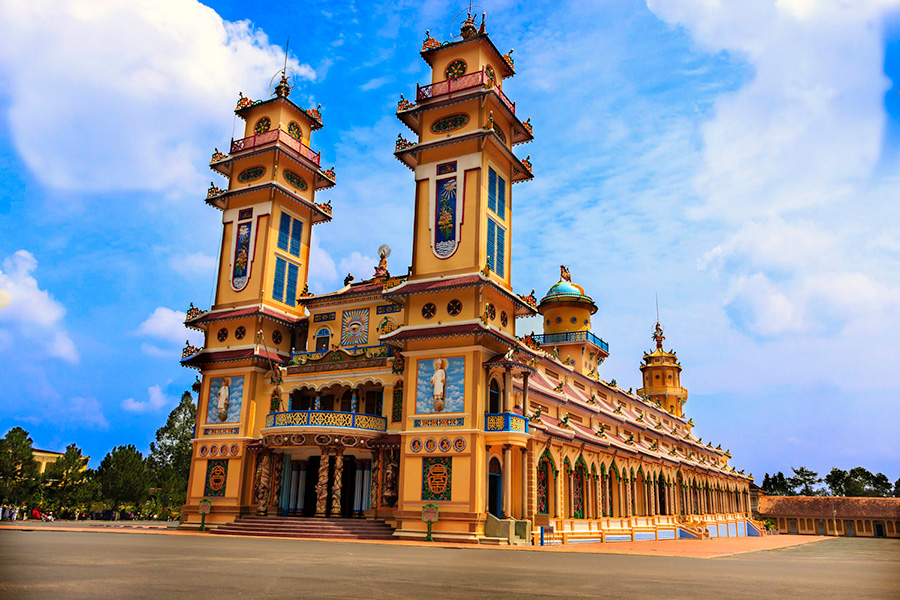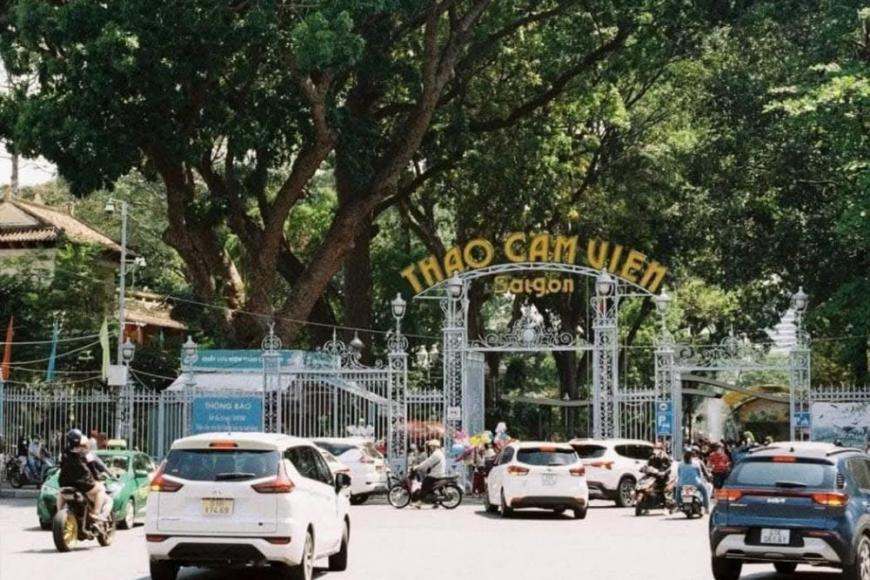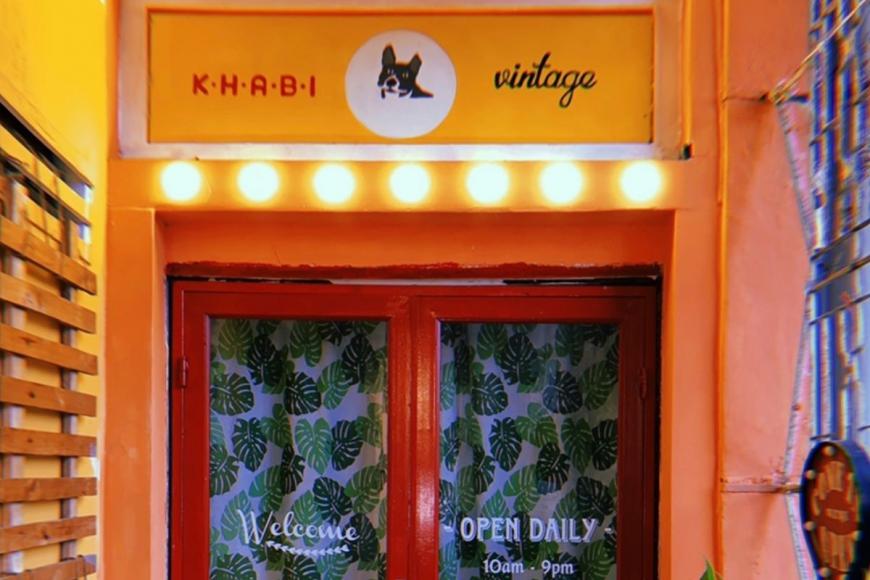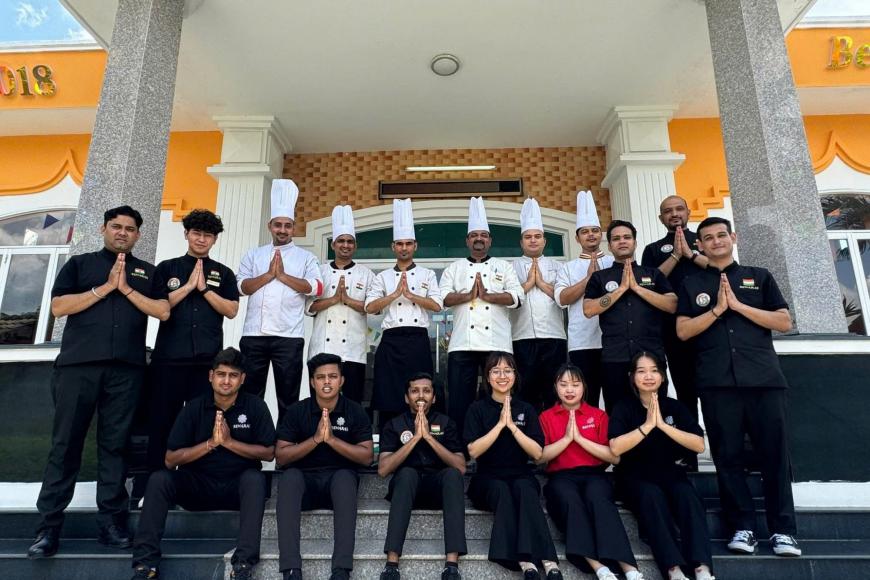- Nha Trang Travel Information
- Muine Travel Information
- Hue Travel information
- Cantho travel information
- Sapa travel information
- Ha Giang Travel Guide
- Ninh Binh Travel Information
- Quy Nhon Travel Information
- Vietnam Travel Information
- Hoian Travel Guide
- Vung Tau Travel Information
- Quang Binh Travel Information
- Phu Quoc Travel Information
- Ha Tinh Information
- Ca Mau information
- Quang Ninh Travel Information
- Tay Ninh Travel information
- Hoian travel guide
- Tien Giang travel guide
- Con Dao Travel information
- Ninh Thuan information
- Moc Chau information
- Danang Vietnam Travel Information
- Hanoi Travel Information
- Ho Chi Minh Travel Information
- Dalat Travel Information
Caodaism: Major Religion of Vietnam
Caodaism: Major Religion of Vietnam
- Overview of Caodaism
Caodaism as it is often spelled, literally means high palace or Kingdom of Heaven. In its Vietnamese form, the term Cao Dai is the name of God. The religious center of Caodaism is Tay Ninh in Vietnam. It is known as a blending, or mixing, religion because it holds values and beliefs common to many other organized faiths. The main building of worship is referred to as the Holy See and has a uniquely eclectic design that is reminiscent of the worship buildings of multiple faiths. A Holy See doesn't look like a church, a synagogue, or a mosque but is somehow all of these at once.
Caodaism in Vietnam is a religion which combines elements from many of the world’s main religions, including Buddhism, Confucianism, Christianity, Hinduism, Islam, Judaism, Taoism, as well as Geniism. It is syncretistic in its doctrine, ritual practice, organizational structure, divinities and philosophy.
“Cao” means “high”; “Dai” means “palace”. The word refers to the supreme palace where God reigns and also used as God’s symbolic name. It originated in South Viet Nam in the early twenties and was officially inaugurated in 1926.
- Architecture of The "Holy See" temple

The architectural combination of a church, pagoda and mosque creates an idiosyncratic place of worship. Looking at the garish central hall, you will see that it has nine levels that represent the nine steps to heaven. The impressive colonnade consists of bright pink columns encircled by thick enameled dragons with stylized scales. The dome is filled with a low hanging blue globe decorated with the “divine eye” gazing down at the worshipers. Merely entering the building is a powerful experience. Do you know that this eye is the official symbol of the church, representative of the visions that created this religion? One evening in 1919, in Tay Ninh, Vietnam, Ngô Van Chiêu, a Vietnamese official of the French administration, witnessed the apparition of Cao Dai (literally the "Supreme Deity") during a session of Spiritualism, as a single eye. It was said that Cao Dai instructed him to create a "perfect" religion taking the best teachings from all the religions that were already existing. Ngô Van Chiêu did so and in 1921 he founded a new religion which he called “Caodaism”. The eye became its symbol and was displayed everywhere, in the texts and on the walls of the Caodaist churches, and Tay Ninh became its capital.
- History of Caodaism
The history of this religion underwent three important episodes of revelations. The first and second took place in 6th century before our era. During the first manifestation, God appeared under the three forms of Jewish leader in the Middle East, Buddha in India and Fou-Hi symbolizing the cult of humanity in China. As for the third manifestation, God has decided to reveal himself. This third manifestation based on Buddhism is often called “Ðại Ðạo Tam Kỳ Phổ Ðộ” (Great Way for the Third Universal Amnesty).
Ngô Văn Chiêu, a district head of the French administration in Cochinchina, was the first to worship and receive messages from Cao Đài in 1921. He received a vision of the Divine Eye which is now the symbol for Cao Đài as well as the focus for worship on all Cao Đài altars. On 7 October 1926, Lê Văn Trung (a former elected official of the Colonial Council of Cochinchina and a member of the Conseil de Gouvernement de l'Indochine), and a leading group of 27 Caodaists, the first disciples of Cao Đài, signed the "Declaration of the Founding of the Cao Đài Religion" and presented it to the French Governor of Cochinchina. The Cao Đài faith brought together a number of once underground sects into a new national religion. Their critique of the communist forces until 1975 was a factor in their repression after the fall of Saigon in 1975, when the incoming communist government banned the practice of Caodaism.[16] In 1997, Caodaism was granted legal recognition and unrestricted practice once again.
The Caodaist consider vegetarianism is one of humane service as it doesn’t involve harming other creatures during the process of their spiritual evolution. They follow several different vegetarian regimens; the least rigorous one is to eat vegetarian meals six days a month. However, priests are required to be full-time vegetarians. With brightly robed priests and colorfully painted temples, Caodaist ceremonies are visually spectacular. They occur four times each day: 6 am, noon, 6 pm and midnight. Women enter the temple from the left, walk clockwise around the hall, and then congregate on the left side for worship. Conversely, men enter from the right and walk counter-clockwise. Both genders give offerings that range from the conventional incense, fruit and flowers to more unusual gifts of tea and alcohol.
Nowadays, The Caodaism religious currently have 2 to 3 million followers in Vietnam and about 25,000 members elsewhere, primarily in Asia, Australia, Canada, Europe and the United States.
Go back!
other
Thao Cam Vien Park is located in Ho Chi Minh city center, which is a home of many animals and plants in the south of Vietnam. This is a must visit destination for tourists exploring an interesting place in Saigon. So, if you are planning to visit Ho Chi Minh, don't miss out on Saigon Zoo.
Saigon Opera House is the perfect destination to enjoy interesting performances and explore unique architecture. With the Western European style, tourists feel that you are in poetic Paris without Saigon city. Don't miss out on an opportunity to visit the Opera House when you come to Ho Chi Minh.
Are you looking for a fashion store with affordable price in Ho Chi Minh? 14 Ton That Dam is the perfect choice for you. Vietnam Trust Car Rental offers some fashion stores at 14 Ton That Dam that you refer. Let's explore it.
Enjoying a cup of Vietnamese coffee is an interesting experience when you travel in Vietnam. Ho Chi Minh city is known for its unique cafe culture with many kinds of cafes from traditional to international blends. You can enjoy delicious cafes at coffee shops in Ho Chi Minh city. These shops offer good drinks and stunning virtual living space, allowing many beautiful photos on the social platform. Refer some best view cafe shops in Saigon in this guide.
Are you looking for the best Cu Chi Indian restaurants in Ho Chi Minh After exploring the Cu Chi Tunnel Tour by private car ? Experience the delicious lunch with your family and friends with the top 4 best Cu Chi Indian restaurants in Ho Chi Minh in this guide. Let’s explore it.








